Blockage is a problem that sooner or later all owners of both apartment buildings and country cottages face. But to solve a sudden misfortune, it is not always possible to attract a professional master.
Let's take a closer look at how to eliminate the blockage in the bathroom on our own and what measures to take in the future to prevent the problem,
Any blockage is formed as a result of violation of the established rules for the operation of the sewage system. In multi-storey buildings, the blockage can be local - within the same apartment, or general, when the common sewer main is clogged.
The reason for the blockage of the pipe in the bathroom can be:
- settling on the walls of mud lumps formed from particles of fine debris and hair;
- layering of fatty deposits on pipes;
- insufficiently sustained pipe slope at the installation stage;
- deterioration of the sewer system as a whole.
Households can not always keep track of what is deposited on the drain grate. Animal hair, fabric fibers and long hair, together with the waste water, drain into the drain and get stuck in it.
If the fibers are not removed in time, then with the next portion of the drained water, they fall into the sewer pipe, where they gradually layer, forming a lump that delays the passage of water
The choice of the best way to eliminate local blockage within the apartment depends on the size of the mud "plug". The general blockage will most likely have to be eliminated with the use of professional equipment.
Mechanical methods of elimination
The fight against clogging of the pipe passage channel should be started as soon as even a slight stagnation of water is detected. You can solve the problem using one of the methods described below. To achieve the maximum effect, it is worth trying to apply two approaches at once, carrying out mechanical and then dry cleaning.
Using a rubber plunger
The easiest and at the same time gentle way to eliminate small blockages is to use a plunger. The tool can be equipped with an elastic flat washer or tapered attachment. The shape of the rubber bowl of the tool is selected depending on what degree of compression is required on the unit being cleaned.
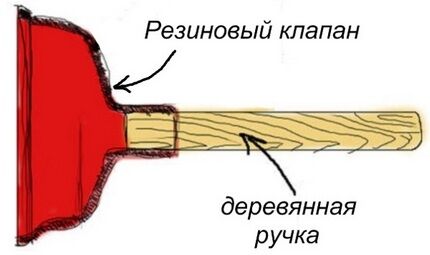
The structural elements of the plunger are a cone-shaped or bowl-shaped nozzle made of dense rubber and a comfortable handle made of wood or plastic
When choosing this method of eliminating the problem, it is worth considering that it is much more difficult to break through the mud plug with a plunger through the drain hole of the bathroom bowl than through the sink drain. This is due to the design of the bath drain, complemented by an overflow hole. When a blockage forms and water overflows over the edge, air accumulates inside the opening, while a vacuum is required to operate the plunger.

To make it easier for yourself, it is important to correctly select the size of the tool; ideally, the size of the rubber bowl of the device should correspond to the diameter of the drain hole of the plumbing fixture
Before you break through the blockage in the bathroom with a plunger, you need to tightly close the overflow hole. This can be done using a rubber stopper or a piece of fabric folded in several layers. Some craftsmen use another plunger to close the hole. But in this case, the work should be done together: one covers the overflow, the other cleans the drain.
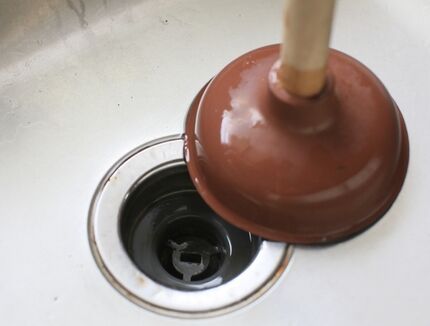
To ensure a snug fit of the rubber plunger bowl to the surface, in order to prevent its displacement during the "pumping" process, it is recommended to pre-cover the nozzle with a layer of petroleum jelly.
The work to remove the blockage is performed in several stages:
- Press the plunger bowl tightly so that it completely covers the drain hole.
- 10-12 sharp reciprocating movements are performed, without lifting the nozzle from the surface, so that the air abruptly departs towards the drain hole, and the blockage is shattered.
- With a sharp movement, remove the tool from the drain. Open the water and rinse the pipe with crushed dirt.
If the applied efforts did not bring the desired effect, it is worth trying to push through the mud seal not with air, but with water. For this purpose, 10-15 liters of hot water is poured into the bath so that it covers the rubber bowl of the instrument by 2/3. The plunger is immersed in water at an angle and several reciprocating movements are performed.
With the last “pitching”, the instrument is abruptly removed from the water and it is observed whether it begins to sink into the drain. If necessary, the procedure is repeated 3-4 times.
Plumbing cable application
To eliminate more global blockages, a plumbing cable made of galvanized steel metal is used. The only thing is that it should be used with great care for cleaning chrome-plated and polymer pipes, the inner surface of which may be damaged when exposed to the sharp ends of the "brush".
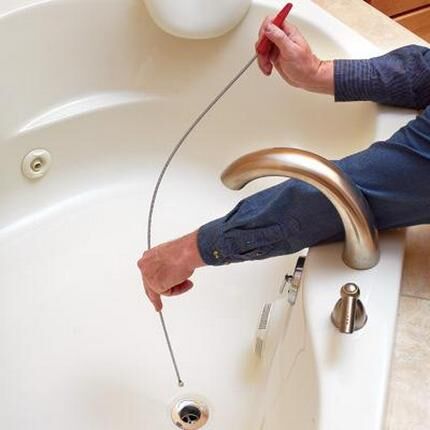
A plumbing cable is a thick twisted wire coiled into a spiral, supplemented with a handle for transferring rotation to the core and a working end in the form of a brush or hook
For work, you can use the factory tool of both rope and spring-wound performance. The task of the master is to hook the blocking object with the help of a brush or hook located at the end of the tool and pull it out, or, on the contrary, push it into a wider part of the line.
In the absence of the opportunity to purchase a tool, you can make it yourself. To do this, take a two-three-meter section of a flexible metal cable, the end of it is slightly "fluffed", forming an impromptu brush.

The flexible tool easily moves along the pipe, easily overcoming all the bends and joints of the sewage system connected to the plumbing equipment on its way
Before you clean the tight blockage in the bathroom, you must carefully inspect the instrument for mechanical damage. It is advisable to lubricate the bushings located near the cable handle.
Cleaning using a cable is performed in the following sequence:
- The tip of the cable is buried in the drain hole, clamping the handle of the tool in your hand.
- Push the cable, making rotational movements.
- Upon reaching the clogged area, a couple of sharp jerks back and forth are performed, increasing the pressure.
- Carefully remove the cable, picking up the debris with the nozzle.
- Open the tap and run hot water in order to flush the pipe with the crushed plug.
The plumbing cable must be taut when cleaning the dirt plug. The rotation of the tool during the pushing process contributes to the fastest destruction of the plug.
Cleaning the siphon device
Stagnation of water, accompanied by the appearance of a characteristic unpleasant odor, may indicate that a plug has formed in the walls of the siphon. This structural element performs two tasks at once: it prevents the penetration of sewage odors and protects the system from the ingress of foreign objects.
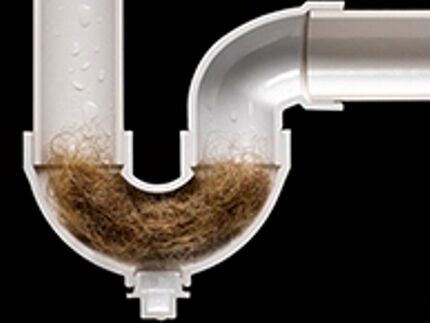
If you accidentally dropped a small but valuable thing into the drain, it is highly likely that it will settle in the siphon; it will not be difficult to remove it by disassembling and cleaning the device
Before disassembling the siphon, directly under its location, it is necessary to spread a piece of old cotton fabric that absorbs moisture well.
The siphon is cleaned in the following sequence:
- A container with low sides is installed under the location of the siphon, where the liquid from the disassembled structure will drain.
- Unscrew the locking nut and disconnect the flask from the outgoing pipe.
- Water is drained from the flask, which served as a water seal.
- At the siphon, the bottom is unscrewed and cleaned of accumulated deposits, wiping the surface from the inside with a sponge and washing it out with a stream of water.
- The flask is installed in its original place, docking with the outgoing pipe.
- Open the tap so that water fills the water seal and check the integrity of the connections.
When assembling the structure and installing the flask in its original place, it is important to place it in such a way that the drain pipe does not rest on it. If you do not adhere to this requirement, the water seal will be broken when the system is started.
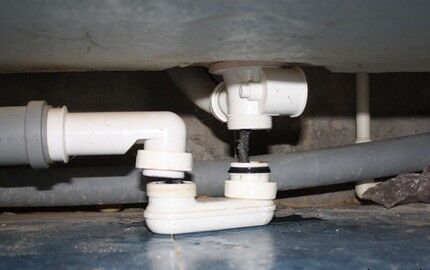
When cleaning the inner walls of the disassembled siphon, it is necessary not only to wash out the dirt lumps, but also to remove the plaque formed on the walls
Lumps of debris removed from the siphon do not need to be drained into the sewer so as not to clog the system. It is best to dispose of them as household waste.
Faithful helpers - chemicals
The modern market offers many ready-made preparations that allow you to decide how to effectively remove a blockage in the bathroom. The active ingredients of the formulations are capable of softening and breaking down organic deposit plugs. They are available as:
- liquid concentrates;
- semi-liquid gels and foams;
- dry powders.
The main thing when working with chemicals is to withstand the concentration indicated by the manufacturer and the waiting time. Even the safest formulations are only able to provide beneficial effects within a certain time period. With prolonged contact, they can even cause deformation of the material from which the pipes are made.

Granular and powder "blockage removers" are considered the most effective, but gels are less dangerous for the condition of pipes and human health.
It is quite easy to use ready-made preparations. They are simply poured into the drain hole and wait for the time specified by the manufacturer. Then open the tap and rinse the pipes abundantly with a stream of water.
If a powdery composition is selected for cleaning, after falling asleep into the drain cavity, it is poured with a small portion of water and the time specified by the manufacturer is waited. Further, as when working with liquid formulations, the system is flushed with a plentiful portion of warm water.
The most popular drugs from leading manufacturers that have proven themselves in terms of eliminating blockages:
- "Mole" - a liquid concentrate based on sodium hydroxide and modified acetic acid, easily removes fat deposits. Due to the aggressiveness of the components of the composition, it cannot be used for processing plastic pipes.
- "Tiret" - a gel-like composition quickly and effectively removes any kind of blockage. It is suitable for both metal and plastic pipelines.
- "Flup" - a granular preparation easily removes limescale, collagen fibers and fatty layers.
- Mister Muscle is a multipurpose gel-like product suitable for all types of pipes. In addition to its main function (destruction of mud plugs), the drug kills bacteria, thereby helping to get rid of the unpleasant odor from the drain.
- "Bagi Pothan" - a preparation based on caustic soda effectively removes even the most severe blockages, which include food debris, hair and lime deposits. Its only drawback is a pungent chemical odor.
Most of the drugs described are based on acids and alkalis, for example, caustic soda. Therefore, when working with them, it is important to observe safety precautions.

To protect yourself and your pets using chemicals in the bathroom, it is important to provide not only natural ventilation, but also to create forced ventilation.
In order to protect the mucous membrane and skin from chemical burns when working with reagents, it is worth equipping yourself properly, wearing goggles, an oilcloth apron and rubber gloves.
Effective folk way
The time-tested folk remedy will also help to eliminate the problem. A solution of soda ash with vinegar gives a good effect. Soda reacts with acid and produces large amounts of carbon dioxide. In a closed space, he pushes the congestion.

To enhance the effect at the time of the release of carbon dioxide due to the interaction of soda with vinegar, you need to tightly close the drain hole after filling the components
Instead of vinegar, you can use citric acid or freshly squeezed juice of one lemon. In any case, the prepared product will not “hit the wallet” much.
Sequence of actions:
- Pour ½ pack of baking soda into the drain hole.
- After 10-15 minutes, when the powder is tamped, half a glass of vinegar is poured into the hole.
- When the chemical reaction begins, the hole is closed with a plug.
- After 60-90 minutes after the completion of the "boiling", the tap is opened and 5-6 liters of hot water are poured into the hole.
The method using baking soda and vinegar is effective only for removing blockages located close to the drain. The farther the plug, the less the pressure of the emitted gas.
How to prevent a problem for the future
Regular prevention will help to avoid trouble in the future. To protect the pipeline system from the accumulation of dirt lumps, the drain hole must be equipped with a simple device - a protective grid.

Coarse-mesh metal or plastic mesh will trap hairs and hairs from animals without restraining waste water flows
It is also worth pouring small portions of hot water into the drain every week. It will melt fat deposits, promoting their further movement along the highway.
The use of chemicals has a good prophylactic effect. To achieve the desired result, they should be used at least once every six months. But in order to minimize the risk of damage to the pipes, they should be used in accordance with the instructions.

Any manufacturer's line of "emergency" chemicals necessarily contains less concentrated prophylactic agents
To minimize the risk of dirt seals, it is recommended to periodically disassemble and flush the siphon elements.
Conclusions and useful video on the topic
We remove the blockage with improvised means:
Cleaning pipes with a plunger:
Cleaning pipes using a wire rope:
Correct operation of plumbing equipment in combination with regularly carried out preventive measures will prevent the occurrence of "traffic jams" and extend the service life of the system.
